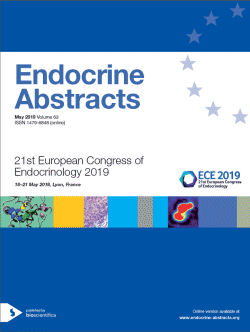
21st European Congress of Endocrinology
Lyon,
France
18 May 2019 - 21 May 2019
ePoster Presentations
Interdisciplinary endocrinology
ea0063ep73 | Interdisciplinary endocrinology | ECE2019
Steatosis in chronic hepatitis C: prevalence and therapeutic impact
Mrabet Soumaya , Jemni Imen , Akkari Imen , Jazia Elhem Ben
ea0063ep74 | Interdisciplinary endocrinology | ECE2019
Cardiovascular manifestations and risk in acromegaly: experience of diabetology-endocrinology department of Oujda’s Mohammed VI university hospital
Yakhlef Salma Ben , Derkaoui Nada , Rouf Siham , Latrech Hanane
ea0063ep75 | Interdisciplinary endocrinology | ECE2019
Short stature revealing Thomsen’s disease: a case report
Imaouen Maryame , Derrou Sara , Benabdelfedil Youssra , El Guendouz Faycal , Ouleghzal Hassan , Safi Soumaya
ea0063ep76 | Interdisciplinary endocrinology | ECE2019
Rare variant of benign premature pubarche in a 6 months old boy
Patrascu Ioana Irina , Nicolaescu Irina Delia , Iancu Elena Mirela , Albu Alice
ea0063ep77 | Interdisciplinary endocrinology | ECE2019
Effect of diets rich in n-3 or n-6 polyunsaturated fatty acids on fibrinogen and haptoglobin on the acute phase response
Nunes Deise W , Carrilho Alexandre J F , Mazzuco Tania L , Silveira Vera L F
ea0063ep78 | Interdisciplinary endocrinology | ECE2019
Assessment of cardiovascular diseases awareness and knowledge among people living with diabetes
Mukhtarova Shakhnoza , Mukhtarova Margarita , Yulduz Urmanova
ea0063ep79 | Interdisciplinary endocrinology | ECE2019
Hidradenitis suppurativa and endocrine disturbance: a case report
Lahouel Maha , Gammoudi Rima , Boussofara Lobna , Hasni Yosra , Ghariani Nejet , Belkahla Marwen , Mokni Sana , Aounallah Amina , Belajouza Colandane , Denguezli Mohamed
ea0063ep80 | Interdisciplinary endocrinology | ECE2019
Hypercortisolemia in Rothmund Thomson syndrome with RECQL4 mutation
Fetoui Nadia Ghariani , Ghariani Najet , Hasni Yosra , Rekaya Mariam Ben , Gammoudi Rima , Kahla Marwen Ben , Hajji Ikram , Aounallah Amina , Mokni Sana , Chaieb Molka , Maaroufi Amel , Abdelhak Sonia , Belajouza Colandane , Boussofara Lobna , Denguezli Mohamed
ea0063ep81 | Interdisciplinary endocrinology | ECE2019
Epilepsy induced by severe hypoglycemia: about three cases
Meryam Elbahi , Sana Rafi , Ghizlane Elmghari , Nawal Elansari
ea0063ep82 | Interdisciplinary endocrinology | ECE2019
Effectiveness and safety of candesartan cilexetil/hydrochlorothiazide combination in jordanian hypertensive patients at risk of cardiovascular disease
Alzoubi Abdallah , Kheirallah Khalid
ea0063ep83 | Interdisciplinary endocrinology | ECE2019
Hyperprolactinemia
ea0063ep84 | Interdisciplinary endocrinology | ECE2019



